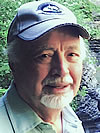 William J. “Bill” Hinze |
2016 George P. Woollard Award
Presented to William J. “Bill” Hinze
Citation by G. Randy Keller
Dr. William J. Hinze is particularly worthy of receiving the George P. Woollard Award based on his long-standing achievements in applying geophysics to study geological problems and issues. In addition, he was among Professor Woollard’s first undergraduate students at the University of Wisconsin. He even implemented the Woollard award when he was chair of the Geophysics Section of GSA and presented the first award to George Thompson, so Dr. Hinze is uniquely tied to Professor Woollard and his heritage.
A short history of his accomplishments begins after receiving his B.S. degree in geology and physics from the University of Wisconsin in 1951. He began by originating and implementing engineering and mining geophysical research programs, respectively, at the U.S. Army Corps of Engineers’ Research and Development Lab and the Jones and Laughlin Steel Co. He then received his Ph.D. in geophysics from the University of Wisconsin in 1957 and joined the faculty of Michigan State University to develop a program in solid-earth geophysics. After rising to the position of full professor, he joined the newly organized Department of Geosciences at Purdue University in 1972 to develop a similar program. Dr. Hinze has served as major professor for 21 Ph.D. and 69 M.S. candidates.
At least six federal agencies and a variety of private industrial and research organizations have supported his research. He has played a major role in developing and applying geophysical techniques, particularly potential-field methods, to the exploration of the continental crust. His work involved scales varying from landfills to satellite investigations of regional crustal structures, and his research, focused on the North American continent, has led to a number of prominent discoveries. Special recognition has been given to his work on rifts and the seismotectonics of the North American craton, which has pointed the way to many ongoing EarthScope studies. He has also played a leading role in developing and analyzing large digital geophysical data sets that have evolved into important resources for EarthScope and other integrated geoscience studies. He has published over 130 scientific papers, co-edited three monographs and co-authored two books.
 2016 George P. Woollard Award — Response by William J. “Bill” Hinze
2016 George P. Woollard Award — Response by William J. “Bill” Hinze
Thanks very much Randy for the kind citation, and thanks also to the Woollard Award Panel for selecting me as this year’s recipient of the Woollard Award. I would not be here receiving this award if it were not for my professional colleagues and students. I truly need and want to acknowledge their significant contributions and interest in solving geological questions with geophysical methods. I especially want to acknowledge my students, both graduate and undergraduate at both Michigan State and Purdue Universities, who have participated in our projects. I have been blessed with the opportunity to associate with a very special group of students noted for being bright, motivated, and hard working. I owe them so much for their contributions to our profession. During my 40 years in the trenches, I had some 90 graduate students so I will not name them all here, but I do thank each and every one of them. And I particularly want to thank my colleagues Jim Trow, Don Merritt, Norb O’Hara, Larry Braile, Randy Keller, Ed Lidiak, Dick Wold, Bob Langel, Raymond Olivier, Ralph vonFrese, Afif Saad, Jack Corbett, and others for making our studies important to the geoscience community and our work so enjoyable. And of course I want to thank my wife of over 60 years, Marilyn, and our wonderful daughters for understanding why I was not always there and for encouraging me in my professional efforts. And to my parents who encouraged me to follow my dream of being a “rock guy.” My career has been everything I dreamed it to be.
This award is especially meaningful to me because of my close association with the origin of the award and with George Woollard. I first met George Woollard in 1949 when we both arrived on the Madison campus of the University of Wisconsin and I became his first undergrad. It was obvious that here was a giant of man, not only in stature, but also professionally and personally. George had the mixture of brilliance, charisma, compassion for his colleagues, students, and the world as a whole, insight, and leadership that made him such an outstanding individual, teacher, and professional leader. We who had the opportunity to be one of George’s Boys were truly blessed. So I hope you can see that receiving this award named after this distinguished gentleman who guided my academic training and early professional career is most meaningful to me.
Again my thanks to the Geophysics Division and the GSA for making this award possible and for adding me to the list of distinguished geoscientists who have previously received the award.
